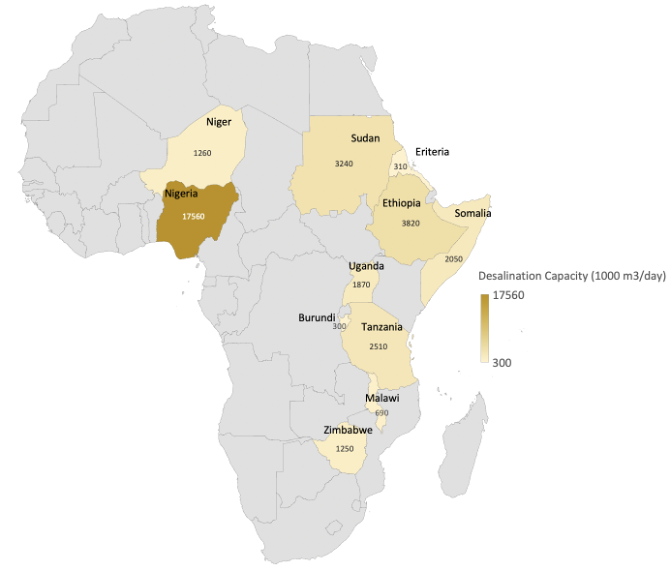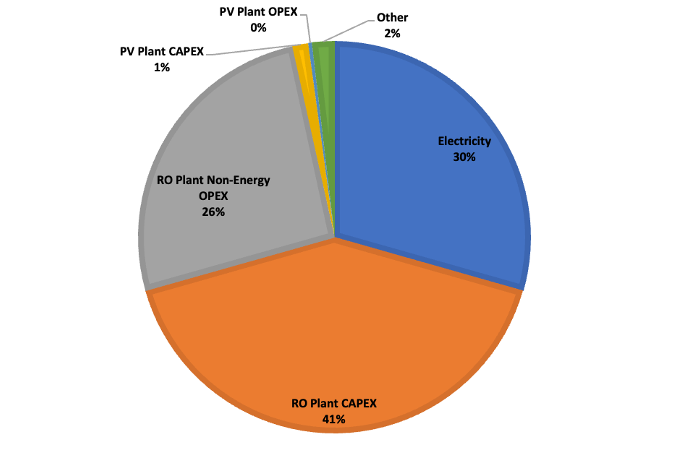How renewable energy can be a game-changer for Africa’s desalination industry
By 2050, it is expected that there will be at least 800 million Africans living in regions with acute water scarcity (where the renewable water resources capacity is less than 1000 m3/capita/year).1 A recent study on the potential growth of the desalination market in developing countries estimated the demand for desalination in Africa’s most water-scarce countries to reach 37 Mm3/day by 2050, satisfying total municipal water demand for urban populations; which is an increase of more than 1500% compared to the current installed capacity in these countries.1
FIGURE 1: Projected desalination capacity in sub-Saharan Africa’s most water-scarce countries by 2050

According to the FAO, the agricultural sector has the highest water demands in these regions, which makes desalination a key enabler for food security.
African governments are already taking serious steps to develop more desalination plants. In Algeria, the government is implementing a new water emergency plan that will prioritize water from desalination. Algeria is already home to Africa’s largest desalination plant, Hamma Seawater Desalination Plant, which has a freshwater production capacity of 200,000 m3/day.
Algeria’s 11 desalination plants currently produce 17% of the national drinking water demand, and the Algerian government is planning to develop 4 new desalination plants, increasing the country’s cumulative desalination capacity to nearly 3 Mm3/day.2,3 In Egypt, the government announced plans to invest $8.5 billion by 2050 to develop 47 desalination plants through public-private partnerships. South Africa is also exploring desalination more seriously to contribute to the country’s water security.4 In Morocco, a new large-scale desalination plant with a capacity reaching 275,000 m3/day was recently developed through a PPP model. Namibia has also announced plans to develop a desalination plant to supply water to the capital city.
Renewable energy can be a game changer for the desalination industry
Desalination is an energy-intensive process and energy costs account for the majority of a plant’s typical operating expenditures (over 40%). In reverse osmosis (RO) plants, which are the most energy-efficient, the energy requirements are 3.5 – 5 kWh/m3, which translates to 44% of the total water cost, which is typically 0.98-1.82 $/m3 in RO plants.5,6 While technological developments in membrane manufacturing can decrease the levelized cost of water by increasing efficiency, the real opportunity is in driving down energy costs.
FIGURE 2: Comparison of the typical operating expenditures (Opex) for thermal and RO plants5

Many African countries have high-quality solar (PV) resources that could provide a significant source of cheap power for growing desalination demand. Plants using a PV-RO configuration have been gaining traction in research and pilot projects.7,8 While running a desalination plant off of solar+storage is likely not economic (LCOE at least 80% higher than solar alone), there are isolated projects where an RO plant is connected to the grid and paired with a nearby PV plant with an annual production profile equal to or greater than the RO plant’s demand. This approach is the one currently employed at Al-Khafji solar desalination plant in Saudi Arabia (the first utility-scale solar desalination plant in the world) and also in the Sydney and Perth RO plants in Australia.
Generally, desalination plants need to run as close to 100% of the time as possible, so the primary impact of widespread solar use will be in driving down the average energy costs, which can make broader deployment of desalination economically feasible.
FIGURE 3: Typical LCOW breakdown for a solar PV-RO plant (capacity assumed is 330,000 m3/day and PV plant size is 6.3 MW).
Africa’s Future Desalination Industry
While the desalination market in North Africa is growing steadily (and currently accounts for almost 80% of the continent’s installed capacity), the sub-Saharan region market is still nascent.13 The installed desalination capacity in sub-Saharan Africa is currently around 1.5 Mm3/day, which is 35 times less than the capacity in the Middle East and North Africa region.14 Furthermore, few African countries have formally included desalination in their water resources management strategies. However, as more African countries have started realizing the urgency of managing their renewable water resources in a more sustainable manner, the market opportunity for renewable energy-powered desalination is expected to grow. The rapid growth of the solar PV market in Africa will be an enabler for renewable energy-powered desalination by driving down energy costs.
The renewable energy revolution could drive complementary growth in desalination, and provides a unique opportunity for African countries to meet their growing water demand while developing their local renewable energy industry. However, a number of key interventions by African governments, the private sector, and research institutions are required to reap this opportunity:
- Formally recognize desalination as a key element in national water strategies. Unfortunately, desalination was not considered in the African Development Bank Water Strategy 2021-2025 nor in the Water Strategy 2018-2030 of the African Ministers’ Council on Water. Including desalination in national water strategies plays a key role in catalyzing market growth by setting expectations about policy.
- More advocacy for the technical and economic feasibility of solar-powered RO plants. Given the historically “conservative” nature of the desalination industry, the adoption of new technologies tends to be slow. Hence, international developers, renewable energy companies, and research institutions should play a more active role in advocating for solar-powered RO as a reliable and cost-competitive technology. Utility companies should be closely engaged in this dialogue.
- Invest more in modular and decentralized solar desalination systems. While large-scale desalination delivers lower average cost of water, it is constrained by high capital investments, complex financing requirements, and large land utilization. Decentralized and modular solar desalination systems overcome these challenges and can support the socio-economic development of remote and rural communities, despite higher average costs.
- Implement supporting policy instruments such as quotas, preferential purchase tariffs, and environmental attribute certificates to incentivize developers of renewable energy-powered desalination projects.
- Explore the feasibility of implementing water trade agreements between African countries to exchange desalinated water for power, treated wastewater, or high-value commodities.
Endnotes
- Nirajan Dhakal, Sergio G. Salinas-Rodriguez, Jamal Hamdani, Almotasembellah Abushaban, Hassan Sawalha, Jan C. Schippers, and Maria D. Kennedy, “Is Desalination a Solution to Freshwater Scarcity in Developing Countries?” Membranes, vol. 12, 2022. https://doi.org/10.3390/membranes12040381
- Aquastat Database. Food and Agricultural Organization of the United Nations. https://tableau.apps.fao.org/
- Inès Magoum. Article in Afrik21. 2022. “Algeria: AEC to build seawater desalination plants in five cities”. https://www.afrik21.africa/en/algeria-aec-to-build-seawater-desalination-plants-in-five-cities/
- Jean Marie Takouleu. Article in Afrik21. 2022. “South Africa: Drought-stricken Nelson Mandela Bay opts for desalination”. https://www.afrik21.africa/en/south-africa-drought-stricken-nelson-mandela-bay-opts-for-desalination/
- World Bank. 2019. “The Role of Desalination in an Increasingly Water-Scarce World.” World Bank, Washington, DC. https://openknowledge.worldbank.org/handle/10986/31416
- Enrique Rosales-Asensio, David Borge-Diez, Ana Pérez-Hoyo, Antonio Colmenar-Santos, “Reduction of water cost for an existing wind-energy-based desalination scheme: A preliminary configuration”, Energy, vol. 167, 548-560, 2019. https://doi.org/10.1016/j.energy.2018.11.004
- Shalaby, S. (2017). Reverse osmosis desalination powered by photovoltaic and solar Rankine cycle power systems: A review. Renewable and Sustainable Energy Reviews, 73, 789-797. https://doi.org/10.1016/j.rser.2017.01.170
- V. Fthenakis. 2016. New prospects for PV powered water desalination plants: Case Studies in Saudi Arabia. Brookhaven National Laboratory. https://www.osti.gov/pages/servlets/purl/1425175
- IRENA. 2022. Renewable Power Generation Costs in 2021. https://irena.org/publications/2022/Jul/Renewable-Power-Generation-Costs-in-2021
- Emillano Bellini. Article in PV Magazine. 2021. “Utility scale solar reaches LCOE of $0.028-$0.041/kWh in the US, Lazard finds”. https://www.pv-magazine.com/2021/11/05/utility-scale-solar-reaches-lcoe-of-0-028-0-041-kwh-in-the-us-lazard-finds/
- Official website of the Sydney Desalination Plant. https://sydneydesal.com.au/
- Azinheira, G.; Segurado, R.; Costa, M. Is Renewable Energy-Powered Desalination a Viable Solution for Water Stressed Regions? A Case Study in Algarve, Portugal. Energies 2019, 12, 4651. https://doi.org/10.3390/en12244651
- “Frost & Sullivan study shows desalination investments in Africa on the rise”. 2019. https://www.frost.com/news/press-releases/frost-sullivan-study-shows-desalination-investments-in-africa-on-the-rise/
- DesalData. 2020. Available online: www.DesalData.com
- Africa Solar Industry Association (AFSIA). 2022. Annual Solar Outlook. http://afsiasolar.com/data-center/outlook-report/

